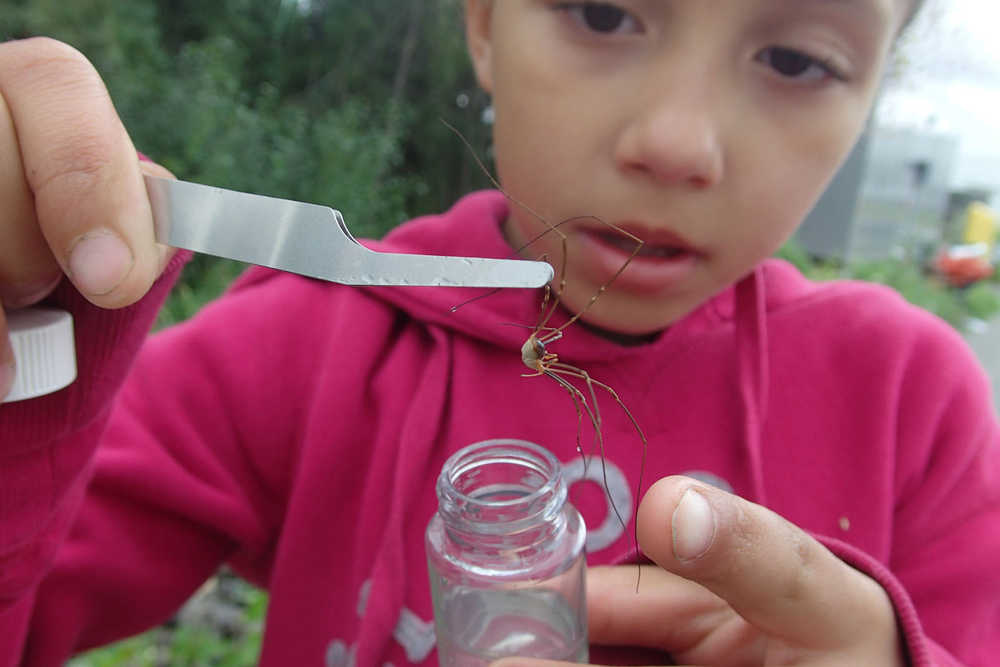OUTSIDE THE UA MUSEUM OF THE NORTH — “Look, it’s a crab spider eating a moth!” says Declan Griswold, an 8-year-old who points to a rose bush.
“You’re right, it’s a true spider, an orb weaver, just like the kind in Charlotte’s Web,” says Derek Sikes, head of the entomology collection at the University of Alaska Museum of the North.
He and his wife Melissa are leading a group of 18 elementary-aged kids in the university’s bug camp, a weeklong summer program.
Because my daughter is attending, I’m doing something I’ve always wanted to do: going to bug camp. During the week, the kids will learn why carrion beetles wear orange (to warn birds that they are gross to eat), how to tease out the ladle tongue of a dragonfly larvae, and the proper spot to spear insects with pins within a handsome white foam box.
“How are you not scared of it?” a girl asks Sikes as he captures the spider, which has dropped the moth. Sikes doesn’t answer, and places it in the girl’s vial filled with alcohol.
The kids are being introduced to scientific collecting, a task that makes many adults uncomfortable. Museum curators kill and preserve birds, mammals, fish, reptiles and insects as part of their jobs. Most of these people are excellent hunters and stalkers. Sikes spends so much time turning over rocks and logs that he carries a rectangle of foam to pad his knees. His endurance, as I witnessed on a muddy island that had erupted a year before, is impressive. And he is lethal with his tweezers.
Using her wooden-handled white net, Mariana Hicks has captured a lovely dragonfly with a long blue abdomen. Sikes pinches its wings between his fingers and asks kids to extend their pointer fingers.
“They have all these spines on their legs for catching their food,” Sikes says. Kids wrinkle their noses as the dragonfly clasps their finger. One asks what will become of the dragonfly. Sikes says it will belong to Mariana.
“Why are you going to kill it?” another girl asks.
“To put it in her collection, so it will last forever,” Sikes responds. “Dragonflies can spend years in the water and just a few weeks flying around.”
The boys and girls quickly get over any moral concerns.
“I’ve killed a lot of bugs, that’s fine,” says Troy Moore.
“Researching on bugs will help us learn about how they live,” says Alejo Lopez.
During bug camp, the Sikes have all of the university’s thousand natural acres behind campus for their field site. They hike the kids down to Smith Lake to net dragonfly larvae and other aquatic insects. Another day, they walk a half mile to the botanical garden.
In 18 vials as long as their fingers, the kids gather a tiny portion of the largest source of biomass in Alaska. Derek Sikes figures that the insects within the UAF leaf litter alone account for about 34,000 pounds of bug per square mile.
For every delicate lacewing the kids capture, a dozen more hang unnoticed within reach of their nets. On these July days, the acreage of UAF hosts billions of creatures living out ephemeral lives that can be as short as one week.
The kids gather bumblebees, beetle larvae, spiders, grasshoppers and even an earthworm. As each gets more practiced at sweeping their nets, they squeal like dipnetters at Chitina.
“I got a spider!” a girl yells.
And there is the reward for Melissa Sikes, a naturalist who works for the Fairbanks Soil and Water Conservation District.
“I really love how enthusiastic the kids are,” she says. “It reminds us of when we were young, chasing insects.”
Her husband, whose summers are filled with trips sometimes spiced with the discovery of a new species (he just got back from Serpentine Hot Springs and will soon leave for Denali Park and then the Aleutians), has inserted bug camp into the middle of his field season for the last three summers. Why?
“To inspire new entomologists,” he says.
Back in the museum where the kids gather, looking at some of the trays of neatly pinned dragonflies, grasshoppers and mosquitoes, it’s easy to envision one or two kids remembering this experience. Not too long from now, when these boys and girls have emerged as men and women, a few may talk about these July mornings as the start of something.
• Since the late 1970s, the University of Alaska Fairbanks’ Geophysical Institute has provided this column free in cooperation with the UAF research community. Ned Rozell is a science writer for the Geophysical Institute.

